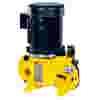Related product with turndown capabilities
Metering pumps are characterized by their ability to meet specific performance requirements concerning linearity, steady state accuracy, and repeatability. Turndown (the adjustable range of a metering pump) and Accuracy are the key to defining the quality and performance of a metering pump.
Turndown Ratio is the rated capacity divided by the minimum capacity that can be obtained while maintaining specified steady state accuracy and linearity.
Example
Rated Capacity: 50 Gallons per Hour
Minimum Capacity: 5 Gallons per Hour
Turndown: 50 / 5 = 10
Turndown Ratio: 10:1
In the above example, the turntown ratio is 10:1. If minimum capacity was 0.5 GPH, the turndown ratio would be 100:1. However, defining turndown without accuracy is meaningless.
Consider the same pump rated at 50 GPH maximum capacity. If you don't define accuracy, technically the pump can be turned down to 0 GPH, in which case the value is infinite.
Defining Accuracy requires two inputs:
- The percentage range expressed as a ±value
- A qualifier that actually defines what true value is of the stated percentage
Metering pumps usually have an accuracy of ±1%. Manufacturers use full range/scale, steady state at set point or repetitive as a qualifier to define accuracy. Steady state at set point is the only useful qualifier of the accuracy percentage range for a metering pump. Let us look at each qualifier in detail and why steady state at set point is the best qualifier.
Full Range or Full Scale Accuracy
Uses the maximum capacity of the pump as a valve. In our example above:
- Accuracy of ± 1% of full scale
○ 1% of full scale = 0.5 GPH - Accuracy at 100% capacity setting (50 GPH)
○ 50 GPM ± 0.5 GPH
○ 0.5 / 50 = 1% of set point - Accuracy of 10% capacity setting (5 GPH)
○ 5 GPH ± 0.5 GPH
○ 0.5 / 5 = 10% of set point
Full scale accuracy is not very accurate. From our 50 GPH example above, 1% of full scale = 0.5 GPH. No matter where we set the pump’s capacity, its flow specification allows an error of plus or minus 0.5 GPH, which in total is actually twice that because it’s ±. So the error range is 1 GPH.
When the pump is set at 100% capacity, it is an easy to understand calculation because it equals ± 1%. However when the pump is set at 10% capacity, the allowable variation is still equal to 1% of the maximum capacity. So the user expects 5 GPH, but with a possible ± error of 0.5 GPH. The actual allowable deviation, by specification, is now ± 10% of the pump's set point – an error range equal to 20% of the pump's setting. This is not metering pump accuracy. To achieve accuracy the Steady State at Set Point must be set.
Steady State at Set Point Accuracy
Uses the current capacity setting of the pump as the value. From above example:
At 100% capacity setting, 1% = 0.5 GPH
At 10% capacity setting, 1% = 0.05 GPH
Steady state accuracy is the only useful accuracy for a metering pump. It’s measured at the pump’s current capacity setting. The value of the flow changes based on the capacity setting because the percentage is based on the setting, not the maximum pump rating.




.jpg?format=pjpeg&width=100&quality=10)


